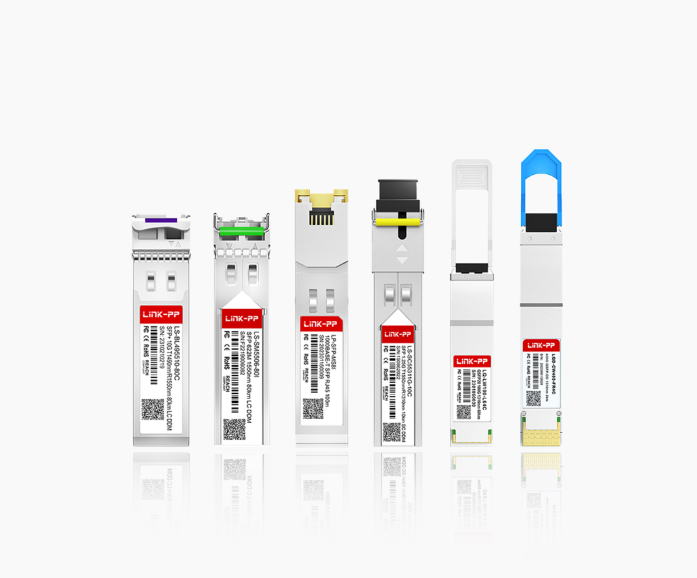
In the world of networking, choosing the right transceiver module can significantly impact performance, cost, and scalability. While optical transceivers dominate long-distance communication, Copper SFP modules offer a unique advantage for short-range applications. This article explores the features, benefits, and key differences between Copper SFP modules and traditional optical transceivers, while introduce application of LINK-PP's Copper SFP Module in modern networking.
What is a Copper SFP Module?
A Copper SFP, also known as an SFP to RJ45 transceiver, is a hot-pluggable networking module designed for transmitting data over copper cables (e.g., Cat5e, Cat6). Unlike traditional optical transceivers that use fiber optics, Copper SFPs leverage electrical signals, making them ideal for short-reach connections (up to 100 meters). These modules are widely used in switches, routers, and network interface cards (NICs) to support Ethernet protocols like 10/100/1000BASE-T.
These modules work with regular Ethernet cables like Cat5e, Cat6, and Cat6a, making them very useful. For instance, a 10G copper SFP module can send data at speeds up to 10Gbps over 30 meters. This makes them great for connecting devices in the same room or building.
Tip: Copper SFP modules can also send power and data through one cable using Power over Ethernet (PoE). This makes setting up devices easier and reduces extra wiring.
Why are copper SFP modules special?
They work with existing copper cables, saving money on upgrades.
They use less energy and cooling compared to fiber options.
They are tough and can handle physical damage, making them good for industrial use.
If you want to improve your network without spending too much, copper SFP modules are a smart choice.
How Does a Copper SFP Work?
Copper SFPs convert electrical signals from network devices into a format suitable for transmission over twisted-pair copper cables. Here’s a simplified workflow:
Signal Conversion: The module’s integrated circuitry converts serial data from the host device into electrical impulses.
Cable Transmission: Signals travel through copper cables via RJ45 connectors.
Reception & Decoding: The receiving SFP decodes the electrical signals back into usable data.
This process ensures seamless compatibility with existing copper infrastructure, eliminating the need for costly fiber upgrades in short-range setups.
Advantages of Copper SFP Modules
Copper SFPs offer unique benefits compared to optical transceiver modules:
Feature | Copper SFP | Optical Transceiver |
|---|---|---|
Transmission Medium | Copper cables (Cat5e/Cat6) | Fiber optic cables |
Max Distance | Up to 100m | Up to 120km (single-mode) |
Cost | Lower (no fiber cabling required) | Higher (fiber infrastructure costs) |
Power Consumption | Moderate | Low |
Ideal Use Case | Short-range, budget-friendly networks | Long-haul, high-bandwidth applications |
Key advantages include:
Cost Efficiency: Avoids expensive fiber installations.
Backward Compatibility: Works with legacy copper cabling.
Ease of Deployment: Plug-and-play design simplifies upgrades.
Reliability: Less susceptible to EMI in controlled environments.
Applications of Copper SFP Modules
Copper SFPs are versatile across industries:
Enterprise Networks:
Connecting switches to servers or workstations in office environments.
Supporting PoE (Power over Ethernet) devices like IP cameras.
Data Centers:
Short-reach links between racks or within server clusters.
Redundant links for failover configurations.
Industrial Automation:
Reliable communication in factory floors with SFP to RJ45 modules.
Application | Recommended Copper SFP Type |
|---|---|
Office LANs | 1G Copper SFP (10/100/1000BASE-T) |
Data Center Interconnects | 10G Copper SFP+ (10GBASE-T) |
PoE Deployments | Gigabit Copper SFP with PoE+ Support |
LINK-PP’s Copper SFPs are trusted for industrial-grade durability, ensuring stable performance in harsh conditions.
Why Choose LINK-PP Copper SFPs?
When selecting Copper SFPs, compatibility and durability are critical. LINK-PP, a leader in optical and copper transceiver solutions, offers:
Full compatibility with Cisco, Juniper, and HP switches.
Advanced diagnostics via Digital Optical Monitoring (DOM).
Extended temperature range for industrial environments.
Advanced Thermal Management reduces overheating risks in high-density setups.
Extended Warranty 5-year support for mission-critical deployments.
For example, the LINK-PP 1000BASE-T Copper SFP LP-SFP-MSRI supports auto-negotiation and delivers stable performance in high-density setup.
Conclusion
Copper SFP modules bridge the gap between cost-effective copper cabling and modern high-speed networking needs. While optical transceivers are indispensable for long-haul communication, Copper SFPs provide an unbeatable value for short-range, high-efficiency deployments. Brands like LINK-PP ensure seamless integration, whether you’re upgrading an office LAN or optimizing a data center.
By understanding the strengths of both Copper SFPs and optical transceivers, businesses can build scalable, future-proof networks tailored to their unique requirements.
FAQ
How far can a copper SFP module send data?
Copper SFP modules can send data up to 100 meters. They work well for short distances in offices or data centers using Ethernet cables.
Are copper SFP modules usable with older devices?
Yes, they are! Copper SFP modules fit most older devices with SFP ports. They let you upgrade networks without needing new equipment.
Do copper SFP modules allow Power over Ethernet (PoE)?
Yes, they do! Many copper SFP modules support PoE. This means one cable can power devices like phones or cameras while sending data.
See Also
The Importance Of Digital Monitoring In Optical Transceivers




